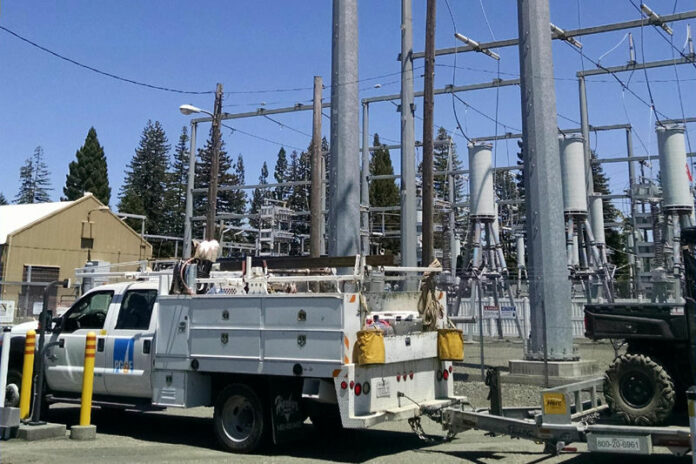
Some big decisions about PG&E will be made in the next few months, and local officials are realizing this could have enormous implications for Sonoma County.
By June the utility hopes to resolve its bankruptcy, which it filed in January because it faced an estimated $30 billion in wildfire liabilities.
The bankruptcy has opened the door to a flood of ideas for restructuring PG&E, and in the chaos, local officials worry that their citizens could get stuck with a big bill.
That’s because rural counties like Sonoma bear most of the fire risk caused by PG&E’s equipment, and currently they can share costs with an estimated 16 million ratepayers across PG&E’s 70,000-square-mile territory.
But proposals to break PG&E into smaller regions could force rural areas to pay for their own upgrades, estimated at billions of dollars.
“Any solution will require sharing of infrastructure repair and maintenance costs and any future fire liability across all of PG&E’s current territory,” Sonoma Clean Power said in a statement last week.
Sonoma Clean Power is a Santa Rosa-based community choice agency that supplies most of the power PG&E delivers in Sonoma and Mendocino counties. Last week its locally elected board of directors urged their chief executive Geof Syphers to explore ways for PG&E to be restructured.
“We believe PG&E may need to be restructured and that an option for a customer-owned utility should be explored, but some proposals threaten to put much of the rebuild cost on rural residents, where faulty equipment is sparking firestorms. We are fully engaged in this reorganization struggle to prevent that from happening,” Syphers said in an email to Sonoma West Publishers.
Syphers is an influential voice because he recently became president of the board of directors of Cal-CCA in Concord, the lobbying arm for the state’s 19 community choice agencies. They buy electricity for 10 million customers throughout California, including 40% of PG&E’s ratepayers.
Here are some proposals for PG&E’s future. Bankruptcy court judge Dennis Montali and the California Public Utilities Commission, both in San Francisco, share authority to make these decisions.
• No change: PG&E and stockholders led by hedge funds have asked the bankruptcy court to approve their plan to settle with creditors and fire victims and emerge from bankruptcy with promises to be safer.
• New investor ownership: Hedge funds that own distressed PG&E debt, aligned with a group of fire victims, have asked the bankruptcy court to choose their plan to restructure the company.
These two proposals maintain PG&E as an investor-owned utility, which critics say is a failed model that must be replaced. Some worry the hedge funds could sell off profitable segments and leave high-cost rural regions to fend for themselves.
“The proceedings appear dominated so far by a pitched battle between Wall Street titans for control of the bankruptcy process, control of the company and the ability to control exit financing. This is merely spectacle without regard for what will be left behind when the financial players inevitably leave the scene,” said a Nov. 4 letter signed by 22 California mayors. See their letter attached.
• Customer owned: Those 22 mayors, including from Windsor, Petaluma, Sonoma and Cotati, have asked the California Public Utilities Commission to reorganize PG&E into a nonprofit mutual benefit company, that is, a cooperative owned by its customers. Employees and basic operations would continue but as a co-op.
They argue that a mutualized PG&E will have more money to tackle needed repairs than an investor-owned utility because it can borrow more money at lower cost, doesn’t have to pay dividends to shareholders and is exempt from federal taxes.
“It’s time to stop paying credit card rates on fixing the grid. A customer-owned utility will help us afford to repair PG&E’s decades of neglect,” said Mark Landman in a prepared statement. Landman is the chairperson of Sonoma Clean Power’s board of directors and a Cotati councilmember.
The mayors did not estimate the cost of the buyout, which they would finance with borrowed money. A mutualized PG&E would not be able to sell stock. All financial risk would fall to customers instead of investors.
• Franchise competition: The state’s Public Advocates Office, which claims it advocates on behalf of ratepayers, has asked the public utilities commission to set clear safety and performance goals for its utility franchises and then invite potential PG&E competitors to apply for the northern California franchise.
“Treating PG&E as the ‘only game in town’ validates its culture of entitlement. California deserves better,” the office said in its appeal to the commission.
This plan aims to improve utility performance without losing investor financing.
“Ratepayers need utility investors as much as utility investors need ratepayers,” it said.
See the appeal attached.
• Municipalized: San Francisco, Yolo County and their community choice agencies have offered to buy PG&E wires in their communities so they can become municipal utilities that both buy and deliver power, like Healdsburg’s electric department.
For an urban area like San Francisco, where most wires are already underground, municipalizing could avoid having to share rural-area costs. San Francisco offered PG&E $2.5 billion. The utility said the price was inadequate, and the utility is not for sale.
• State ownership: Lawmakers including California Gov. Gavin Newsom have mentioned state ownership as a possibility.
• Grid upgrades: Interest in microgrids, battery storage, underground wires and other ways to stabilize power delivery is high, but so is the cost.
• Other possibilities: A judge in a public utilities commission proceeding has asked for comments on proposals to separate PG&E into gas and electric utilities, sell the gas business, change PG&E’s internal structure and link shareholder return to safety performance.







